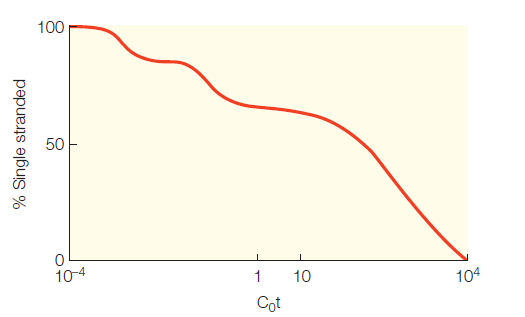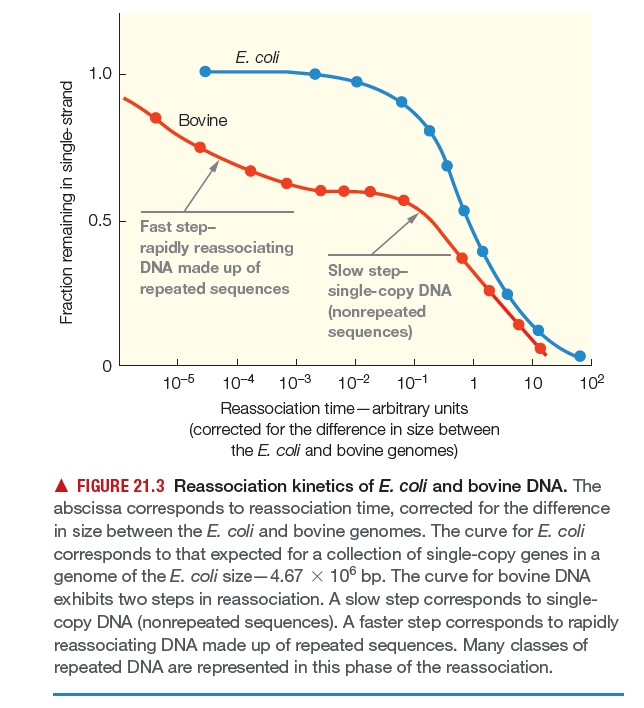100 104 10 104 Cot % Single stranded E. coli 1.0 Bovine 0.5 Fast step- rapidly reassociating DNA made up of Slow step- single-copy DNA (nonrepeated sequences) repeated sequences 10-5 10-4 10-3 10-2 10-1 1 10 102 Reassociation time- arbitrary units (corrected for the difference in size between the E. coli and bovine genomes) A FIGURE 21.3 Reassociation kinetics of E. coli and bovine DNA. The abscissa corresponds to reassociation time, corrected for the difference in size between the E. coli and bovine genomes. The curve for E. coli corresponds to that expected for a collection of single-copy genes in a genome of the E. coli size-4.67 x 10° bp. The curve for bovine DNA exhibits two steps in reassociation. A slow step corresponds to single- copy DNA (nonrepeated sequences). A faster step corresponds to rapidly reassociating DNA made up of repeated sequences. Many classes of repeated DNA are represented in this phase of the reassociation. Fraction remaining in single-strand
Molecular Techniques
Molecular techniques are methods employed in molecular biology, genetics, biochemistry, and biophysics to manipulate and analyze nucleic acids (deoxyribonucleic acid (DNA) and ribonucleic acid (RNA)), protein, and lipids. Techniques in molecular biology are employed to investigate the molecular basis for biological activity. These techniques are used to analyze cellular properties, structures, and chemical reactions, with a focus on how certain molecules regulate cellular reactions and growth.
DNA Fingerprinting and Gel Electrophoresis
The genetic makeup of living organisms is shown by a technique known as DNA fingerprinting. The difference is the satellite region of DNA is shown by this process. Alex Jeffreys has invented the process of DNA fingerprinting in 1985. Any biological samples such as blood, hair, saliva, semen can be used for DNA fingerprinting. DNA fingerprinting is also known as DNA profiling or molecular fingerprinting.
Molecular Markers
A known DNA sequence or gene sequence is present on a chromosome, and it is associated with a specific trait or character. It is mainly used as a genetic marker of the molecular marker. The first genetic map was done in a fruit fly, using genes as the first marker. In two categories, molecular markers are classified, classical marker and a DNA marker. A molecular marker is also known as a genetic marker.
DNA Sequencing
The most important feature of DNA (deoxyribonucleic acid) molecules are nucleotide sequences and the identification of genes and their activities. This the reason why scientists have been working to determine the sequences of pieces of DNA covered under the genomic field. The primary objective of the Human Genome Project was to determine the nucleotide sequence of the entire human nuclear genome. DNA sequencing selectively eliminates the introns leading to only exome sequencing that allows proteins coding.
DNA renaturation curves occasionally show three distinct phases of renaturation. In this graph, DNA renaturation is plotted against C0t (initial
concentration times time of renaturation—essentially a measure of relative
renaturation time). See Figure 21.3.
(a) Identify each part of this plot that corresponds to reannealing of (1)
unique sequences, (2) moderately repetitive sequences, and (3) highly
repetitive sequences.
(b) Suppose that you cloned a single-copy gene, such as the gene for dihydrofolate reductase (DHFR), into a plasmid vector and subjected it to
renaturation analysis. Sketch the curve you might expect.
(c) Suppose that you used reverse transcriptase to copy the ovalbumin mRNA and cloned this complementary DNA (cDNA) into a plasmid vector. Would you expect this cDNA to reanneal (1) more slowly, (2) more rapidly, or (3) at the same rate as genomic DNA? Briefly explain your answer.


Trending now
This is a popular solution!
Step by step
Solved in 3 steps with 3 images






